Executive Summary
The Nova Scotia Health Survey 1995
The 1995 Nova Scotia Health Survey (NSHS95) was a population-based
survey implemented by Heart Health Nova Scotia in partnership with the
Nova Scotia Department of Health. Support was provided by the World Health
Organization MONICA Project, the Department of Community Health and
Epidemiology and the Population Health Research Unit of Dalhousie Medical
School, and the Department of Psychology at Dalhousie University.
Financial support was provided by Health Canada through the National
Health Research and Development Program (NHRDP), the Heart and Stroke
Foundation, and the Nova Scotia Department of Health.
Designed as a follow-up to the 1986 Nova Scotia Heart Health Survey,
the NSHS95 was expanded to estimate the health status of Nova Scotians for
selected health indicators and participation in preventive practices. The
results provide baseline information about the current health of the
population and describe changes in cardiovascular disease (CVD) risk over
the past decade. This information will be invaluable to the process of
health system renewal as policy makers attempt to direct limited resources
wisely and plan effective policies and programs. A collaborative approach
to public health research was undertaken and it combined the efforts of
representatives from provincial and federal governments, academics, and
leading experts in health research.
There were 3,227 men and women, age 18 and over, who participated in
the survey from across the province. The data were collected by trained
public health nurses during a home interview and a subsequent clinic
visit.
Summary of Results

Personal and Social Well-being
Satisfaction With Health
- 92% of Nova Scotians were somewhat or very satisfied with their
health.
- Older men were most likely to be very satisfied with their health.
- Older women were less likely to be satisfied with their health.
Activity Limitation
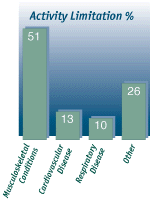
- 17% of Nova Scotians reported activity limitations due to poor
health.
- The most common causes of limitation were musculoskeletal conditions
(51%), cardiovascular disease (13%), and respiratory problems
(10%).
- Injury or accident was the cause for 30% of people with activity
limitations.
Caregiving
- 8% of Nova Scotians were identified as caregivers who helped
children with special needs and adults by providing assistance with
activities of daily living.
- Although nearly half of these caregivers found the job stressful,
most were able to cope.
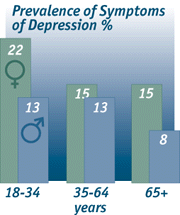
Depression
- 1 in 7 Nova Scotians reported symptoms of depression and the rates
were higher in women than men.
- 22% of young women 18-34 reported symptoms of depression.
Physical Health and Prevention
Weight
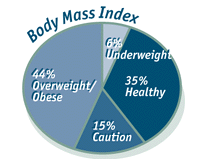
- 35% of Nova Scotians had a healthy weight (BMI = 20-25).
- 44% were overweight to obese, and more men than women were in
this category. Most people who were overweight acknowledged they were, and
more overweight women than men were trying to lose weight.
- 24% of women age 18-34 who had a weight that was healthy or low
were trying to lose weight.
- Exercising and eating lower fat foods were the most common weight
loss strategies.
Blood Cholesterol
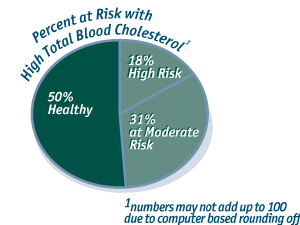
- 49% of Nova Scotians were at risk of heart disease due to
elevated total blood cholesterol (>5.2 mmol/L), and within this
group, 18% were at high risk (>6.2 mmol/L).
- Total blood cholesterol levels increased up to age 64, levelling off
in men but continuing to rise in women.
Blood Pressure
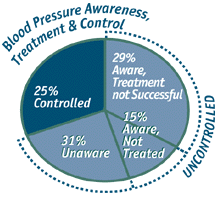
- Nearly all Nova Scotians reported having had their blood pressure
checked at least once.
- One-quarter of Nova Scotians had high blood pressure
(>140/90 mmHg and/or were on treatment for high blood
pressure). Of those found to have high blood pressure, most did not have
it under control.
Smoking and Second-hand Smoke
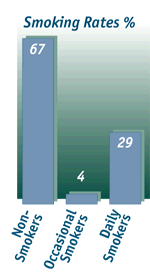
- 29% of Nova Scotians smoked daily and in this group, one-third
were heavy smokers (>25 cigarettes per day). Men were more
likely to be smokers and heavy smokers than women.
- One-quarter of Nova Scotians were exposed to second-hand smoke at
work and 23% of Nova Scotians reported health problems as a result of
exposure to second-hand smoke.
- Up to one-third of women in the child-bearing years (18-44) smoked
daily.
Physical Activity
- 61% of Nova Scotians reported participating in leisure time
physical activity at least once a week during the past month.
- 39% were inactive (sedentary), with women more likely to be
inactive than men.
- Sedentary living increased with age, such that 49% of men and
66% of women over 65 were inactive.
Alcohol Consumption

- Three-quarters of adults consumed alcohol in the past year and men
consumed alcohol more often and in greater quantities than women. Men were
also more likely to be heavy drinkers (>5 drinks/occasion) than
women.
Multiple Cardiovascular Disease Risk Factors
- 70% of Nova Scotians had one or more of the major risk factors
for CVD (high blood cholesterol, high blood pressure, smoking).
- 25% of Nova Scotians had two major risk factors for CVD.
Chronic Illness
- One-quarter of adults suffered from a chronic health problem, and
36% reported suffering from three or more.
- The most common chronic conditions included allergies,
arthritis/rheumatism, and back problems.
Prevention and Screening Practices
- Breastfeeding levels have risen, with more than 40% of women of
childbearing age breastfeeding for at least one month.
- Flu immunization levels were very good in people over age 65, but
only 25% of adults under age 65 and considered at risk were immunized
in the 1994/1995 flu season.
- 72% of adult women performed a breast self-exam in the past year.
In those over age 40 (the age for breast cancer screening), only 51%
had had a manual breast exam by a health professional in the past year.
- Annual Pap test screening was low for peri- and post-menopausal women
where less than half had had a PAP test in the last year, but 91% of
all women reported having had a Pap test at least once in their lifetime.
- 68% of men age 50-70 had had a prostate examination, but only
29% indicated it was in the last year.
Comparison Between the Prevalence of Cardiovascular Disease Risk
Factors and Behaviours: 1986 - 1995
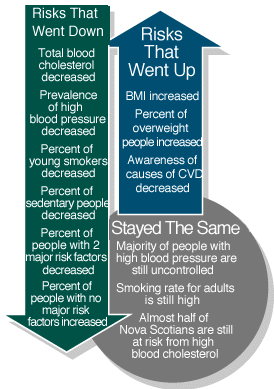
- Compared to 1986, more people are free of the major risk factors and
fewer adults have two major risk factors for CVD.
- The average total blood cholesterol went down in the past decade
(from 5.31 mmol/L to 5.24 mmol/L in 1995).
- The percentage of people who were overweight (BMI > 27)
increased from 36% to 44% in 1995.
- The average weight of Nova Scotians has increased since 1986, with
the average BMI increasing from 26 to 27 in 1995.
- The prevalence of high blood pressure has declined to 22% in 1995
from 26% in 1986.
- Although the overall smoking rate is unchanged from 1986, fewer
people age 18-34 now smoke.
- The percentage of people exercising at least once per week rose from
58% in 1986 to 70% in 1995.
Discussion and Conclusions
The NSHS95 provides a comprehensive picture of the health of adults in
Nova Scotia and this information is now available to all Nova Scotians
interested in managing and improving the health of the population. The
survey results provide an excellent basis from which to strengthen health
policies and programs, and to identify priorities for future action. In
addition, this baseline health information contributes to the selection of
key health indicators which can be monitored to assess progress toward
targets for improved health in the province.
The NSHS95 provides a clear picture of progress toward improved health
in some areas and identifies areas where considerable collective and
individual effort is still needed. Cardiovascular disease continues to be
a key health concern, despite a slight decrease in the prevalence of some
risk factors over the past decade. There have been modest reductions in
the prevalence of high blood pressure and elevated blood cholesterol. As
well, smoking rates have declined considerably in younger age groups.
However, too many Nova Scotians smoke, are overweight, are inactive,
and have many of the risk factors that promote the development of chronic
diseases like cardiovascular disease, cancer, diabetes, and chronic lung
disease. In fact, 70% of Nova Scotians have one or more of the major
risk factors for heart disease. Average weight (BMI) has increased since
1986, and the percentage of the population classified as overweight and
obese has increased substantially. A measure of depression shows that
young women have the highest rates of symptoms of depression in the
population.
There is much that Nova Scotians can do collectively and individually
to change this situation. All sectors at the provincial, regional and
community levels must take responsibility for the creation of healthy
physical and social environments. Governments at all levels have a
responsibility to develop and support policies that make healthy choices
the easier choices for Nova Scotians. Individuals can make personal
changes which will greatly enhance their health. They can stop smoking,
exercise on a regular basis, eat a healthy diet and choose lower-fat foods
more often. These individual choices are made and sustained more easily in
an environment that is supportive of health.
These survey results should be viewed as part of a future research and
planning agenda. Clearly the problems identified in the survey require
that individuals, communities, and a wide range of partners, such as non
government organizations, the academic community, health professional
groups, governments, and the private sector, be involved in an integrated
and intersectorial approach to health promotion. A concerted effort by all
Nova Scotians is needed to further reduce the prevalence of illness and
disability in the province.
[Table of Contents]
[Next: Chapter 1]









